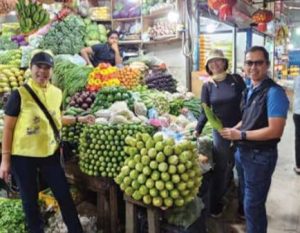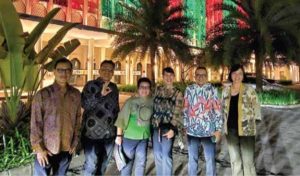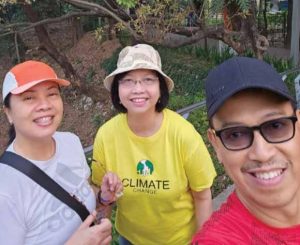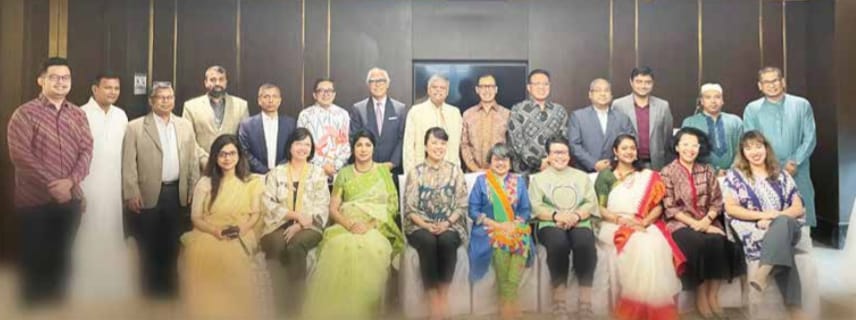Upon our arrival in Bangladesh, we were immediately greeted by a cacophony of sounds: the chatter of people, the relentless hum of traffic, and most prominently, the incessant blare of the car horns. These auditory sensations swiftly ingrained themselves as constant companions throughout our entire journey in Bangladesh.
Stepping foot onto Bangladeshi soil for the first time we did not really have any expectations of what we were going to get. However, Bangladesh promptly left enduring impressions on us.
Our primary purpose in Bangladesh was to co-host the Dialogue on Democracy in Inclusive Society (DDIS) Forum with the Ministry of Foreign Affairs of the People’s Republic of Bangladesh. Yet, we were fortunate to also get a glimpse of multifaceted tapestry that of Bangladeshi life.
We usually started the day with a morning walk, exploring the local park at Ladies Park and Gulshan Lake Park. They offered a much needed sanctuary from the busy city life. Being there you could almost forget that you were actually in the middle of bustling city and instead getting transported into a tranquil green oasis. Maybe due to the fact that it was Ramadhan, we did not meet a lot of people there.

Next, while battling our sleep-deprived bodies, several of us mustered the energy to explore the local market. The atmosphere vibrated with liveliness, and to our delight, we stumbled upon a fruit that was exclusive to the Southern part of Indonesia. Known as “Buah Bidara” in Bahasa Indonesia, in Bangladeshi it bore a different name: Kul. One bite flooded our memories with the sights and smells of our childhood, so it was a fantastic start to our day.
As the day unfolded, our plans to visit Old Dhaka were thwarted by the unrelenting traffic. It does not matter for there were much to see and experience in Dhaka itself.
Upon the advice of a dear friend hailing from Bangladesh and an alumnus of the Indonesian Art and Culture Scholarship, we learned that eating holds a special place in the hearts of Dhaka’s inhabitants.
Embracing this insight, we excitedly embraced the opportunity to indulge in the city’s culinary delights.
The adventure started with the sahoor. Since we arrived in Bangladesh during the Holy Month of Ramadhan, we were fortunate enough to partake on the Bangladeshi Ramadhan experience. This experience added yet another layer of depth to our travel.
Sahoor in Bangladesh was an experience unto itself. Starting at 2 AM, the atmosphere was very festive, with people dressing up, relishing the chance to not only eat but also to spend time with their family. The food choices were plenty including freshly grilled Bangladeshi seafood.
Iftar was always a serious celebration. From the chotpoti to the spicy haleem, to kachchi biryani and fuchka, we were left wide eyed after every bite. Some of the dishes that stood out surprisingly were the vegetarian dishes. Our personal favorite was the daal poori. The daal had such depth of flavor, and the poori was very crispy and comforting. The daal we had was made from red lentils simmered together with spices, tomatoes and broth, and the poori was made from wheat flour, all-purpose flour, and semolina. It was rolled into small discs then deep fried in hot oil. The combination of both left our taste buds dancing.

Another one of our favorite was beef chaap, a comforting food of beef marinated in a paste of poppy seeds, cashew nuts, melon seeds and a few other spices such as yoghurt,grated papaya,safron, kewra water, turmeric powder,kashmiri red chili powder, onions, ginger, garlic, and green chilies. The beef then fried for several hours in low flame, left the beef very flavourful and tender. It was very similar to our Beef Rendang,which we also slow cooked for up to 8 hours.
We also cannot talk about Dhaka without mentioning the traffic. We Indonesians are not strangers to traffic. Traffic in Jakarta is notorious and people spends hours on end commuting from and to work.
However, traffic in Dhaka was something else. The numbers of cars, trucks, rickshaw, CNG, taxis, pedestrians, motorcyle, and people crowding the streets were off the charts; and somehow it worked.
People manouvered their ways between traffic, while constantly communicating by honking. We were convinced that honking was definitely the way Dhaka drivers communicated with each other; for it was a constant presence, even in empty stretch of highway. It was also our first time to see how CNG was present in the international departure at the Hazrat Shahjalal International Airport. Back at our Soekarno-Hatta Airport, only cars were allowed to go to the drop off points at our airports.
That said, our favorite mode of transport was surely the rickshaw. One of the most memorable experiences were riding rickshaw at night, againts oncoming traffic, during the rain. It was hectic, exhilirating and may we say, pretty adrenaline pumping as well. The rain had cleared the air, the temperature had dropped, and the air was cool and refreshing.
We also had the chance to visit Aarong, apparently meant “Village Fair” in Bengali. We used the oportunity to browse and shop ethically made Bangladeshi hand crafted products. From beautiful silk saree, to shalwar kameez set, to colourful embroideries etched in bags, place mat, tablecloth and so many others. The options were endless. We were also spend a healthy amount of time peering over the silver, gold and pearl jewelry.

The wife of our Indonesian Ambassador to Bangladesh shared with us the unique allure of Bangladesh’s pearls, known as “mukta.” These pearls are distinct because the mussels inhabit a habitat that is a blend of freshwater and saltwater, resulting in the natural formation of pink pearls. Intrigued by this, we made sure to contribute to the local economy by investing in these exquisite gems.
Another aspect that deeply resonated with me was the profound patriotism exhibited by the Bangladeshi people. This sentiment was palpable not only during the DDIS but also in our conversations with locals throughout our trip. The historic significance of the 1971 speech by the Father of the Nation, Bangabandhu Sheikh Mujibur Rahman, advocating for civil obedience and proclaiming the struggle for independence from March to December 1971, was deeply ingrained in the collective consciousness of Bangladeshis. The theme of independence reverberated strongly in our interactions with them.
This theme of independence is one that resonates deeply with us Indonesians as well. We, too, endured a lengthy struggle for independence spanning 350 years before finally declaring our independence on August 17, 1945. Even after this declaration, we had to fiercely defend our sovereignty until November 1949 when Indonesia was formally recognized as an independent nation by the Dutch and its allies.
In conclusion, our visit proved to be highly productive and enlightening, offering us valuable insights into the realities of life in Bangladesh. We sincerely hope that this visit serves to strengthen the longstanding ties between Indonesia and Bangladesh.
Written by-
Siti Nugraha Mauludiah
Deputy Minister for Information and Public Diplomacy
Republic of Indonesia


